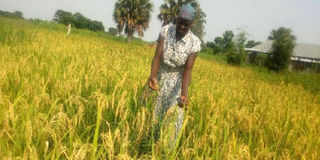Teso loses swamps to rice farming

Ms Anna Grace Abago in her rice garden in Katinge Parish, Kobulubulu Sub-county in Kaberamaido District on Monday. PHOTO | EMMANUEL OLILA
What you need to know:
- The father of 10 revealed that an acre of rice can earn a farmer Shs2m, which is hard to get from a similar garden of cassava or groundnuts.
- Mr Simon Peter Erwangu, the interim chairperson for Kapelebyong District, said as much as the farmers have found an answer to their economic survival in rice farming, they should not destroy the swamps.
More farmers in Teso Sub-region are invading swamps to grow rice due to improved prices, putting the environment at risk, Daily Monitor has learnt.
Traditionally, rice has not been among Teso’s major cash crops. The sub-region has traditionally grown cassava, sorghum, and groundnuts.
But recently, more farmers are taking up rice growing to the detriment of the swamps.
Rice growing in Teso first started in Bukedea before spreading to other parts of the sub-region.
Ms Anna Grace Abago, a resident of Katinge Parish, Kobulubulu Sub-county in Kaberamaido District, told Daily Monitor on Monday that rice farming has turned out to be her family’s financial problem solver for the last six years.
“Unlike other crops whose prices keep fluctuating, rice has fairly given us steady prices. Every year, the prices have stayed steady between Shs2,000 and Shs3,000 per kilogramme . No other crop has generated a constant pay cheque to farmers like rice,” Ms Abago explained. Ms Abago added that rice also takes five months to harvest.
“I have two harvests each year, each earning me close to Shs4 million,” she explained.
Ms Abago said despite the impact of the crop on the environment, they have no option but to carry on with it.
“Other farmers who have had a good harvest of simsim are crying over of low prices. This is the dilemma driving farmers to the swamps to grow rice,” she said.
Although district leaders in the sub-region could not provide statistics of the destroyed swamps, many acknowledged that the water retention areas are at risk due to rice growing.
The Kumi District production officer, Mr Rajab Ogogol, said they are educating the farmers to stop cultivating in swamps but their efforts are yet to bear fruit.
“We have done our part, the other vigilance should be executed by village Local Council chairpersons,” Mr Ogogol said.
Mr Charles Okello, a farmer with 30 acres of rice in Obwobwo Parish, Ongongoja Sub-county in Katakwi District, said they have chosen to invade the swamps for rice cultivation because other crops have failed them.
The father of 10 revealed that an acre of rice can earn a farmer Shs2m, which is hard to get from a similar garden of cassava or groundnuts.
Mr Simon Peter Erwangu, the interim chairperson for Kapelebyong District, said as much as the farmers have found an answer to their economic survival in rice farming, they should not destroy the swamps.
“There are always certain spots of the swamps or wetlands that they are restricted from cultivating in, and that should be adhered to,” he added.




